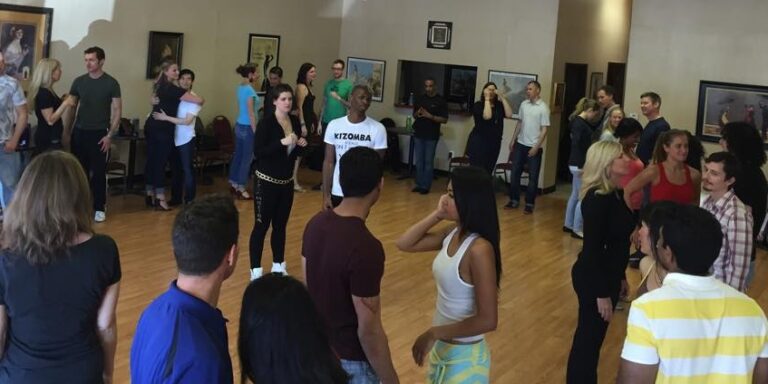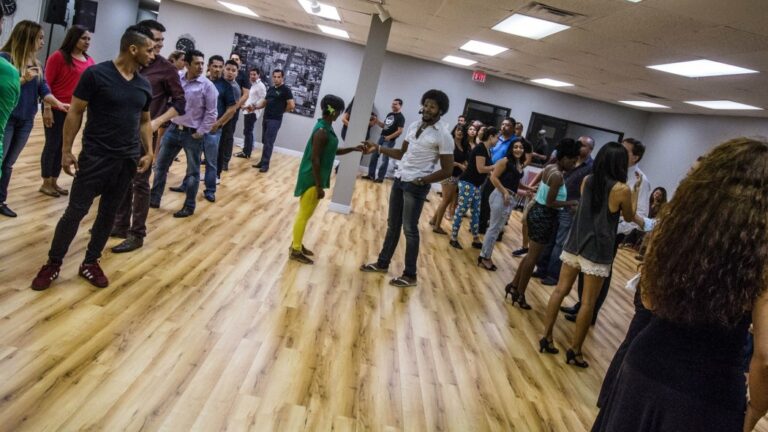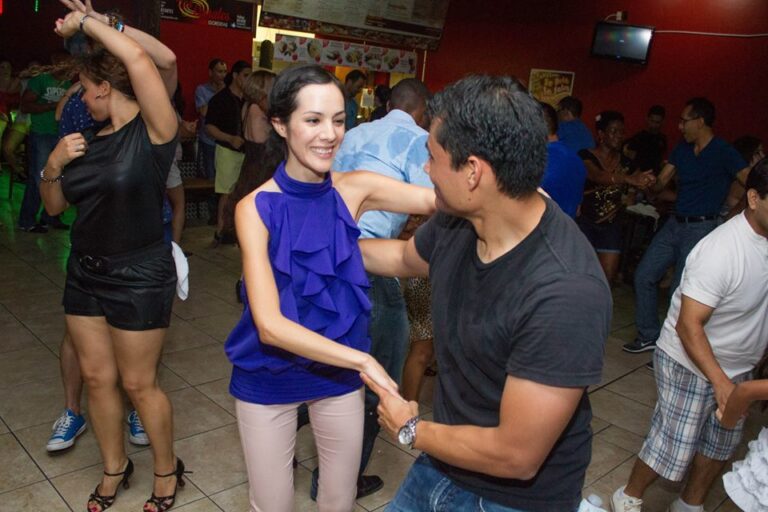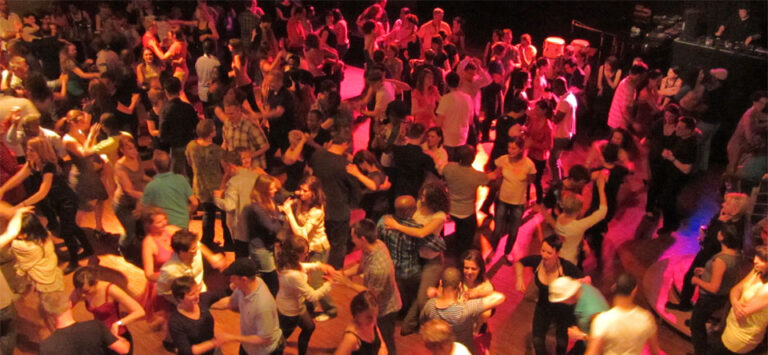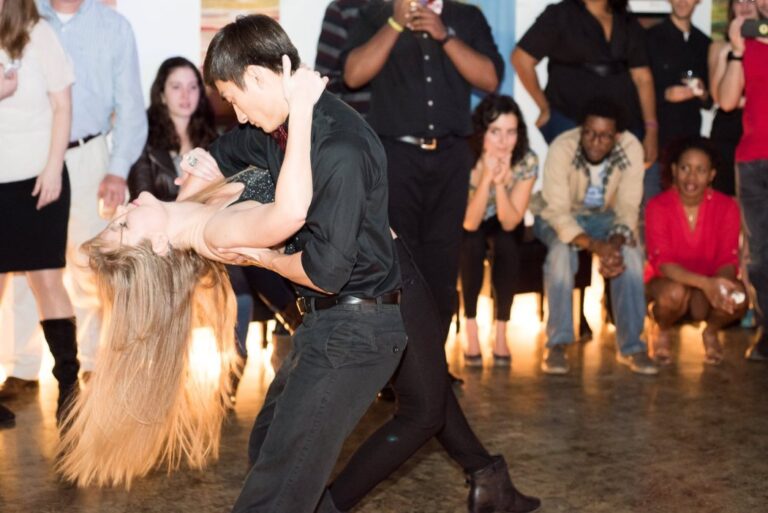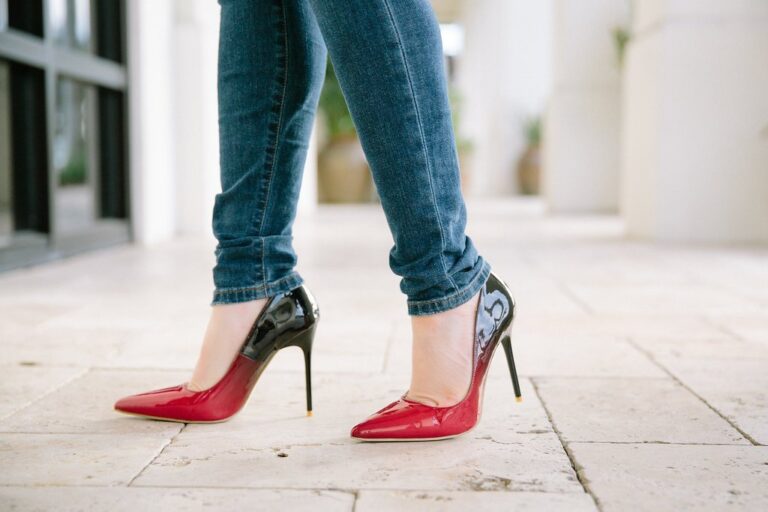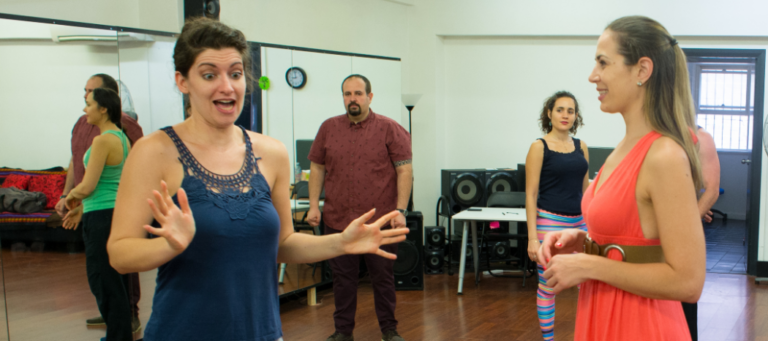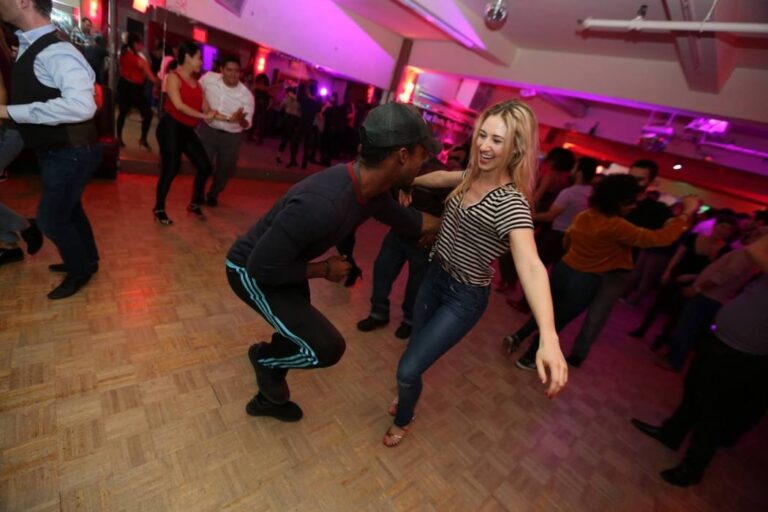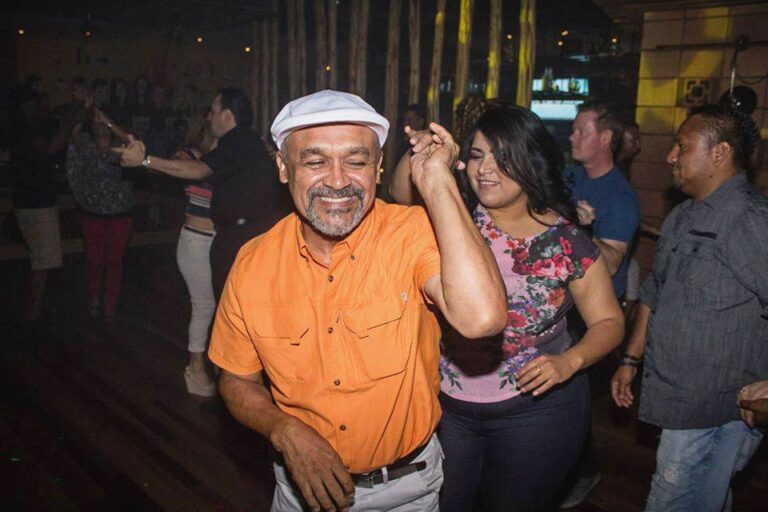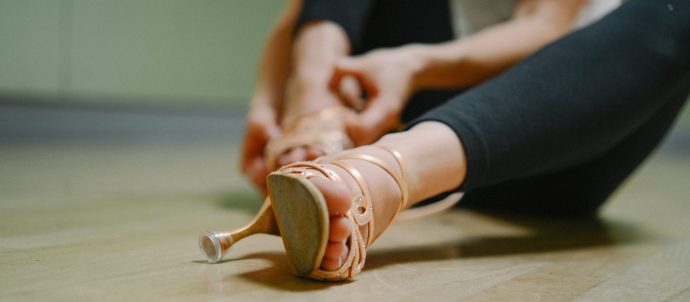However important writing up a code of conduct is, it’s even more important that your community buys into it and that you have protocols in place to support its implementation. The right words aren’t enough – people have to know about them, feel invested, and have confidence that you will act on them. So let’s take a look at how to get people on board, educate newcomers, train up some support, handle feedback, and make the tough calls that will occasionally be needed.
Bringing the Scene Together
Bring together the core members of your scene to have a discussion about your code of conduct. That could be registered members of your club, people who have been attending classes for at least a year, or simply everyone who is interested in the health of the scene. Do make sure the group is sufficiently diverse to represent your scene (including all genders, people of color, different age groups, etc.)
Send the drafted or current code of conduct out by e-mail or post it online and ask that everyone read it beforehand. Then they can bring questions and comments to the meeting.
The whole concept of a code of conduct feels uncomfortable for many people, like a set of unwanted rules or a public declaration that dance venues might be dangerous places. You’ll want to try to help them feel less uncomfortable with the idea of protecting your community’s dancers and values. “Nobody likes to be told what they are doing wrong. They will resist having to deal with shame…” explains Rowen Dawson, founder of ACSS. “Instead of highlighting whats wrong we want to focus on what we can do to achieve [our desired] culture.”
At the meeting, explain the reasons for the various points included, ask for feedback, and discuss possible changes. You aren’t likely to get unanimous agreement on everything, of course, and there may be some points you will need to argue for, but you can seek understanding and compromise. At the end, consider having a referendum on whether the revised code of conduct is acceptable to the scene as a whole.
When a large number of scene members have been part of the process of creating the code of conduct, you’ll have included more perspectives in the end policy, plus the group will feel more invested in it. It becomes a kind of social contract with shared responsibility.
Newcomer Education
When you welcome beginners and people new to your scene, introduce them to the expectations of your community. As Rowen Dawson points out: “That will set the tone and set the parameters for what the event is supposed to be like. Instead of just throwing an event together with some music and a space, think about what kind of space are you creating and how can you make it a space for everyone.”
Try a combination of some of the following:
- Post the code of conduct on your website and link to it when you make Facebook events.
- If you have people sign a waiver before class or complete a registration form for your event, ask them to read and agree to the code of conduct.
- Put signs up at your social or event with some key points. I’ve seen signs that say:
“Ask before: dancing, hugging, dipping, or lifting.”
“We celebrate dancers of every size, shape, color, gender, religion, and ideology. Please help us make everyone feel welcome.”
“Here are 30 reasons someone might say “No” to dancing with you.” - Have your instructors teach the most important elements of consent and etiquette. Check out my articles on teaching both nonverbal consent and verbal consent for some tips. It makes a huge difference when people are specifically taught how to set their own boundaries and make sure they aren’t making their partners uncomfortable.
- Ask the DJ to occasionally offer reminders over the mic.
“The dance floor is for dancing. Please head to the bar for drinks and conversation.”
“Remember, communication is both verbal and nonverbal. Please use your words if something is unclear.” - Talk about the code of conduct during the event introduction or evening announcements. Max Pogonowski, a director of Swingin’ the Blues, advises: “Do it in a serious way but not a scary way; a ‘We care about you’ way. Be matter of fact: ‘We have our code of conduct over there, it’s for your safety,’ not threatening, like ‘you must obey!’”
Volunteer Support
Ask for a pool of volunteers to be community support staff during your socials or dance event. Teachers and organizers already have so many roles to fill in these spaces; it’s important to have others designated to help make sure your scene’s values are being respected and to help dancers with questions, feedback, and complaints.
Consider who might be able to fill that role in your scene, how they will take turns doing it, and how people will find them. Many scenes have their volunteers wear hats, pins, a glowing bracelet, or a similar item to make them easily recognizable.
Include people of different ages, colors and genders as volunteers at each event. “Potential reporters are more likely to share their discomfort if they identify with the staff members,” Jeemin Kim of Latin Dancers for Consent & Safety explains. “Having a diverse group of volunteers can help with talking to the reportee as well – for example chronic male abusers tend to respond right away instead of shrugging it off if a tall/muscular staff member comes over for the ‘chat.’”
It can also help to have a comment box where people can leave written feedback. Sometimes it’s more comfortable for individuals to write anonymously or ask to be contacted privately for follow-up.
It’s essential to get those volunteers and all your leadership some training in listening to complaints and reports of misconduct. There are many kinds of training workshops and online training available, but I’ll just touch on a few key points here:
1. Be welcoming and available. People need to be able to find you and feel they can approach you easily, without feeling like a nuisance. Even better, walk around and check in with people, especially newcomers and beginners. “How’s the evening going? I’m here if you have any questions or feedback.”
2. Listen. Never minimize their experience. It’s hard to make a report, so take them seriously and make them feel heard. This is particularly true for cases of sexual assault – I have encountered huge reluctance from people who’ve confided in me to even share their stories about sexual assault anonymously on my site, let alone making a personal accusation to their scene’s leaders.
3. Support them. Coming forward is a sign of trust, and it’s often an opportunity to nip potential problems in the bud. Especially in cases related to physical breaches of consent, don’t jump right into investigative mode, searching for the facts. “Certainly at some point you’ll want to figure out the details of what happened and what sort of response is right,” says Kate Molski, a DC blues dancer and advocate. “But your first instinct should be to support that person because it’s a really vulnerable position.”
If they feel their report matters to you, they’re more likely to stay in the scene, and it will help encourage others to feel comfortable coming to you as well. You might be surprised what you discover.
4. Check your biases. Are you able to consider that your friends could be responsible for derogatory comments to a person of color? Does it matter to you that a lesbian couple could feel unwelcome in your scene? Do you find it hard to believe that a man could be a victim of sexual assault?
Small Interventions
For most small breaches of your code of conduct, a brief intervention that includes a reminder of the relevant part of the code of conduct can suffice.
“You really can’t wear stilettos on this floor.”
“Please don’t take photos without asking people’s permission.”
Occasionally a warning or clarification of the policy might be needed.
“We don’t allow aerial steps at our social dances. It’s too easy for people to get injured and we can’t afford the liability.”
“In our scene, everyone is allowed to choose the dance role they would like. Please don’t assume someone’s role based on their apparent gender. Just ask, ‘Would you prefer to lead or follow?’”
Action Protocols
For more serious issues, it is extremely helpful to discuss responses and consequences in advance. When do you need to bring someone away from the dance floor and have a conversation with them about their behavior? What would result in someone being asked to leave for the night? When would you call the police? What actions would result in a dancer being banned? What can a dancer do to make amends and return to the scene? Who has the authority to decide?
Most dance scenes don’t include all such procedures in their published code of conduct. Instead, write up a separate “Action Protocols” document that takes local legislation and liability concerns into consideration. It will make it much easier for you to respond when that stressful moment comes. This is particularly important for the emotionally charged incidents like accusations of racial discrimination or sexual assault.
Many dance organizations use some variation of a three-strike policy. Perhaps the first time there is a breach of consent or a racist comment, the person responsible is taken aside for a conversation about the community’s views on that kind of behavior. The second time they may be asked to leave for the night. The third infraction can result in a ban from that event or scene.
Nevertheless, every situation is unique and many require nuanced thinking. Sometimes an action will be so blatantly offensive that an immediate ban is necessary. In other cases additional education might seem suitable. Kate Molski shares, “I think it can be really appealing to have a concrete rule so you can say ‘The process happens, so this happens. I never had to make a judgment call so I can’t be held accountable.’ Even though it’s scary, it’s better to make the judgment call. Give yourself the leeway because it’s always going to be complicated.”
Max Pogonowski admits, “I’m sure a lot of the scene leaders, like myself, have been (or still are) hesitant to ban someone for the “low end” of unacceptable behavior for a variety of reasons – perhaps to give people a chance to change, because the punishment seems disproportionate to the offense, or perhaps because we did something similar in the past. Regardless of the discomfort, it’s important to take action.”
One protocol that can be very helpful is documenting complaints. Kate Molski clarifies: “Some things don’t seem so serious in just one instance…but if this person has ‘accidentally’ groped someone’s breast 8 times, then it’s probably not an accident! If you keep track of it, you can see that pattern.”
I also recommend Safer Dance’s excellent page “Dealing with an Incident,” which explores possibilities for restorative justice as an alternative to punitive justice.
Whatever action protocols you decide on, definitely have your volunteers and staff practice role playing these types of situations and responding accordingly. Try to have enough volunteers that you always have people ready for different roles: welcoming chats with beginners, taking reports of various kinds, gentle clarification of policies after small breaches, stern rebukes, or enforcing someone’s departure.
Position and Power
Of course everyone is against sexual assault…in theory. But it can be difficult to take action when someone you respect or consider a friend is accused. “When it’s people with higher social power, or in the case of dancing, people who’ve been in the dance longer and people who are better at dancing, it costs you something to take the side of a victim. That’s how a lot of people see it – it costs them their friendship or their ability to dance with them,” says Kate Molski.
It’s particularly difficult when the perpetrators are influential people like instructors and DJs. It takes a lot of social capital to go up against such a person as an advocate or organizer, particularly since, as Billy Myles of Kizomba Harmony points out, “the system is heavily skewed towards protecting alleged victimizers, not victims.” So he makes it a point to talk to the instructors for their KHADE festival. “We set the tone by telling them, ‘If you do anything that makes someone not want to come back next year, you’re not coming back next year. This is not your free-for-all….If you’re doing a private lesson, that’s not a come-on. No privates in hotel rooms.’”
I could go on at length, but instead I’ll hand you over to my fellow contributor Tanya Newton’s “A Dance Event Organiser’s Guide to Sexual Harassment and Assault,” which explores a myriad of practical considerations.
Call to Action
“How do we change the culture of people feeling unsafe to report their discomfort,” asks Jeemin Kim, “into one that can empower marginalized people?”
In the end, what matters is the sum of all the actions we take. Every incremental improvement we make towards making our scenes safe and welcoming is valuable.
As a community, we can come together and decide what kind of culture we want to create in our scene. As organizers, we can stay informed and refuse to hire problematic instructors. As volunteers, we can check in with people, listen, and take action to support each other. As dancers, we can be considerate and respectful of every member of scene.
Leave us a comment to say what action you will take for your scene!
Thank you to all those I interviewed who agreed to be quoted. Special thanks to Jeemin Kim for her additional contributions to the shape of this article.
